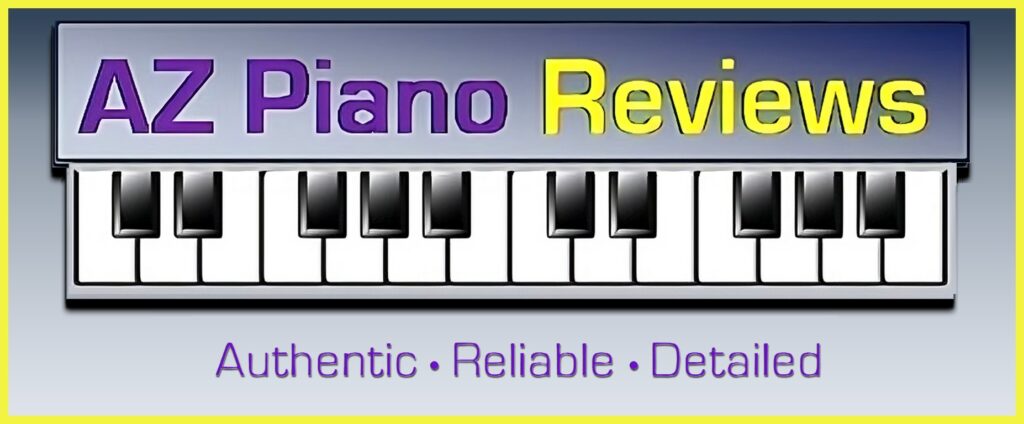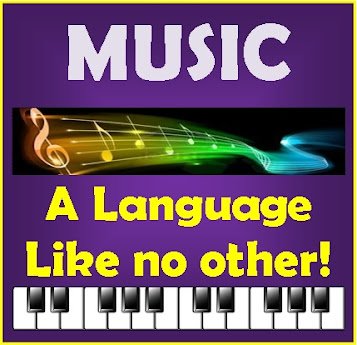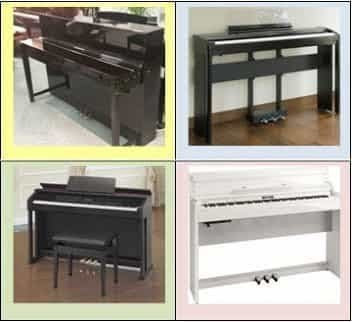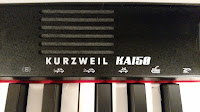 UPDATED REVIEW – June 1, 2018 – Kurzweil KA150 Digital Piano – Not Recommended – The Kurzweil company has been around for many years and in fact was one of the leaders in digital piano technology many years ago. But unfortunately it’s been a long time since Kurzweil was anywhere near the top in the digital piano business. Kawai, Roland, Casio, Korg, and Yamaha have far surpassed Kurzweil in nearly every way when it comes to home digital pianos and keyboards, with the exception of a few higher priced Kurzweil stage pianos…but that’s another category altogether.
UPDATED REVIEW – June 1, 2018 – Kurzweil KA150 Digital Piano – Not Recommended – The Kurzweil company has been around for many years and in fact was one of the leaders in digital piano technology many years ago. But unfortunately it’s been a long time since Kurzweil was anywhere near the top in the digital piano business. Kawai, Roland, Casio, Korg, and Yamaha have far surpassed Kurzweil in nearly every way when it comes to home digital pianos and keyboards, with the exception of a few higher priced Kurzweil stage pianos…but that’s another category altogether.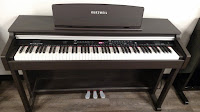 Sometimes I do not recommend a few furniture cabinet digital piano models from famous name brands and in this case I definitely do not recommend this Kurzeil KA150. After carefully playing the KA150 ($899US internet discount price) a number of times, I have determined this piano is not even as good as a $400 Casio portable digital piano in terms of piano sound, key action, pedaling, and features. In fact the main piano sound was so bad in this model that it sounded like a plunky honky-tonk piano to me regardless of whether I played it through internal speakers or through stereo headphones. The piano sound chip only has 68 notes of polyphony which is considered quite small these days and nearly all name brand digital pianos have at least 128-note polyphony processing power which is important to fully reproduce songs that intermediate and more advanced players can play.
Sometimes I do not recommend a few furniture cabinet digital piano models from famous name brands and in this case I definitely do not recommend this Kurzeil KA150. After carefully playing the KA150 ($899US internet discount price) a number of times, I have determined this piano is not even as good as a $400 Casio portable digital piano in terms of piano sound, key action, pedaling, and features. In fact the main piano sound was so bad in this model that it sounded like a plunky honky-tonk piano to me regardless of whether I played it through internal speakers or through stereo headphones. The piano sound chip only has 68 notes of polyphony which is considered quite small these days and nearly all name brand digital pianos have at least 128-note polyphony processing power which is important to fully reproduce songs that intermediate and more advanced players can play.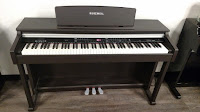 Beyond these concerns is that the plastic feeling key action was too light and somewhat noisy with the piano sound having very little dynamic tonal range overall which limits the musical expression that can come out of the piano. The piano pedals were physically much too light and felt weak and the piano sustain decay time was noticeably short and unrealistic. Also the sustain pedal is just and on/off pedal and does not have the ability to trigger half-damper pedaling (a variable amount of sustain) which I feel is somewhat important and which the competition does have.
Beyond these concerns is that the plastic feeling key action was too light and somewhat noisy with the piano sound having very little dynamic tonal range overall which limits the musical expression that can come out of the piano. The piano pedals were physically much too light and felt weak and the piano sustain decay time was noticeably short and unrealistic. Also the sustain pedal is just and on/off pedal and does not have the ability to trigger half-damper pedaling (a variable amount of sustain) which I feel is somewhat important and which the competition does have.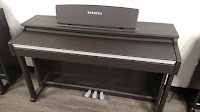 Although the overall volume of the internal speakers is fine with 40 watts of power going through 2 larger speakers, the quality of that sound is poor in my opinion and almost any good name brand portable digital piano for about $500-$700 does a much better job of producing quality tone. If you were hoping this piano might be a good one because the cabinet looked fairly nice, the price is under $1000, and the brand has a long and interesting history, you will definitely want to think twice about that because there are much better options in this price range if you want a good piano playing experience.
Although the overall volume of the internal speakers is fine with 40 watts of power going through 2 larger speakers, the quality of that sound is poor in my opinion and almost any good name brand portable digital piano for about $500-$700 does a much better job of producing quality tone. If you were hoping this piano might be a good one because the cabinet looked fairly nice, the price is under $1000, and the brand has a long and interesting history, you will definitely want to think twice about that because there are much better options in this price range if you want a good piano playing experience.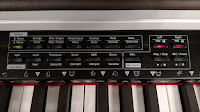 The Kurzweil KA150 does have some fun features built in which include 128 instrument sounds which can be layered or split for any 2 sounds, 11 interactive rhythm and music styles with 15 rhythm banks (total 26 patterns) so that a beginner can play a simple 1-finger or 3-finger chord and the rhythm music styles will fill in with automatic 1-man band arrangements. All of those features are controlled by buttons in the control panel above the keys and are easily accessible. There is a LED display screen with red numbers to indicate which sound or rhythm has been selected and although that LED screen is good to have, it would have been better to get a LCD screen instead which displays actual words, but the LED is better than nothing and more than other pianos have. Although these automated features can be fun to use and help make you sound better than you really are:), few people tend you use them in a digital piano because most people usually want to focus on the piano playing experience and not all the “bells & whistles.”
The Kurzweil KA150 does have some fun features built in which include 128 instrument sounds which can be layered or split for any 2 sounds, 11 interactive rhythm and music styles with 15 rhythm banks (total 26 patterns) so that a beginner can play a simple 1-finger or 3-finger chord and the rhythm music styles will fill in with automatic 1-man band arrangements. All of those features are controlled by buttons in the control panel above the keys and are easily accessible. There is a LED display screen with red numbers to indicate which sound or rhythm has been selected and although that LED screen is good to have, it would have been better to get a LCD screen instead which displays actual words, but the LED is better than nothing and more than other pianos have. Although these automated features can be fun to use and help make you sound better than you really are:), few people tend you use them in a digital piano because most people usually want to focus on the piano playing experience and not all the “bells & whistles.”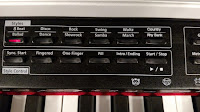
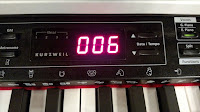 Also, with regard to the automatic accompaniment features I just mentioned, they really don’t sound very good and are more toy-like than what I was expecting. A $200 Casio or Yamaha keyboard has more realistic accompaniments than this Kurzweil…so I was not impressed with what that feature had to offer on this model. So when you look at this piano and all the buttons it has on it, you might think you are getting a lot for the money as compared to other furniture cabinet digital pianos in this price range (under $1000US) but don’t let all those buttons fool you…it’s always first & foremost about “how does the digital piano play as a “piano” and if that part is good then the secondary features (extra sounds, rhythms, etc) becomes the frosting on the cake, so to speak.
Also, with regard to the automatic accompaniment features I just mentioned, they really don’t sound very good and are more toy-like than what I was expecting. A $200 Casio or Yamaha keyboard has more realistic accompaniments than this Kurzweil…so I was not impressed with what that feature had to offer on this model. So when you look at this piano and all the buttons it has on it, you might think you are getting a lot for the money as compared to other furniture cabinet digital pianos in this price range (under $1000US) but don’t let all those buttons fool you…it’s always first & foremost about “how does the digital piano play as a “piano” and if that part is good then the secondary features (extra sounds, rhythms, etc) becomes the frosting on the cake, so to speak.
As far as connectivity in the KA150 goes, this model does a good job with that part offering stereo audio inputs, audio outputs, mini jack MP3 player input, microphone input, USB to device output, and dual 1/4″ stereo headphone jacks. This is more than what is offered on comparability price digital pianos from other brands, so that was impressive to me.
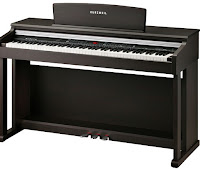 What really makes this piano stand out is the way it looks and its lower price. It is quite natural for people to gravitate towards a nice looking piano that has some nice digital features built in and is low priced, so I do understand that. The cabinet is offered in either simulated rosewood or satin white and it has a 3/4 size privacy panel on the back along with front support legs and a sliding key cover to enhance the appearance and stability of the piano. The piano has a built-in song library for practicing of a variety of lesson songs along with a 2-track MIDI recorder to record music and a digital metronome that helps to keep the beat when learning your rhythm and timing.
What really makes this piano stand out is the way it looks and its lower price. It is quite natural for people to gravitate towards a nice looking piano that has some nice digital features built in and is low priced, so I do understand that. The cabinet is offered in either simulated rosewood or satin white and it has a 3/4 size privacy panel on the back along with front support legs and a sliding key cover to enhance the appearance and stability of the piano. The piano has a built-in song library for practicing of a variety of lesson songs along with a 2-track MIDI recorder to record music and a digital metronome that helps to keep the beat when learning your rhythm and timing.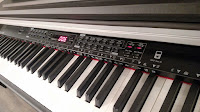 The bottom line is this: there is an acronym that I like to use (PSO) to describe a piano which looks good on the outside but is a poor representation of a piano on the inside. PSO stands for “piano shaped object” and that’s what the KA150 really is…something that looks good on the outside and has some interesting “bells & whistle.” But when it comes to actual piano playing, it offers a fairly poor quality piano playing experience especially as compared to any other name brand digital piano under $1000.
The bottom line is this: there is an acronym that I like to use (PSO) to describe a piano which looks good on the outside but is a poor representation of a piano on the inside. PSO stands for “piano shaped object” and that’s what the KA150 really is…something that looks good on the outside and has some interesting “bells & whistle.” But when it comes to actual piano playing, it offers a fairly poor quality piano playing experience especially as compared to any other name brand digital piano under $1000.


